Apr 30, 2014 | ANA, commentary, technology, web
“I can’t wait to see what a disaster the ANA new web site will be.”

Laura Sperber
I am not taking the statement out of context. It is the first sentence of the paragraph that appears in her Hot Topics blog post at the Legend Numismatics website.
Prior to this statement, I tried to give Sperber the benefit of the doubt. I greatly respect what she has accomplished in a male-dominated industry. I also appreciate her fight against coin doctoring and shining a light on the problems with coin doctoring and the grading services because I think it has made a positive impact. Unfortunately, her statement appears to be like throwing a tantrum for the sake of being right and not getting it right.
There is a difference between having an opinion and arguing to be right rather than investigating the opinion to getting it right. If Sperber was interested in getting it right, she would speak with those working on the project from the ANA headquarters to see what they are doing. If Sperber was interested in getting it right, as a member of the Board of the Governors she could ask to see the contract, project plan, and records of the costs. If Sperber was interested in getting it right, she could have asked the chairman of the Technology Committee for a meeting with the committee members, who are ANA members and professionals in the computing industry, for a frank discussion on the project.
In fact, Sperber could have asked to talk with me at the Whitman Baltimore Expo where Legend Numismatics always has a prominent table. I attended the show on both Friday and Saturday providing ample opportunity to meet and discuss her concerns.
“There is no way anyone can justify the price paid.”
Other than throwing verbal stones at Board meetings or in her blog, Sperber has not reached out to anyone to make sure she gets it right. Not only is the price in line with industry standards but the team working on the project at the ANA’s headquarters have really worked to keep the costs down and prevent overruns. As a long-time critic of the ANA’s technical acumen, Executive Director Kim Kiick and her team has done a phenomenal job.
Sperber may be a good numismatics business person but she is not knowledgeable in the business of technology to understand how foolish she sounds.
“I know I have a far more reaching and complicated new web site that cost me MUCH LESS to build at LM Auctions.”
With all due respect, no you do not. Buying auction and shopping services off the shelf is not difficult or complicated. What is difficult and complicated is choosing amongst the dozens of vendors to provide the service. If you do an Internet search for “create an auction site” you will find the list of vendors and instruction as to how to go about doing this. If you have the technical background, you can build the site yourself using any of these services. Otherwise, there are plenty of people who can be hired to do the work for you.
In creating Legend-Morphy, Sperber and her business partners purchased technology for the auction services from Sebae Data Solutions of Ocala, Florida. Sebae may not be the company that did their integration, but it appears the Legend-Morphy site was built on top of Sebae’s Bidopia auction platform.
How complicated could creating an auction website for this company be when her partner, Dan Morphy Auctions, uses Sebae’s services to manage their auctions? Morphy Auctions is well known and respected in the antique collectibles business, thus it would make sense that if they were to branch out into other areas, they would use proven technologies they are familiar with.
The use of Sebae’s software and services is not a problem. What is a problem is Sperber’s misrepresentation of what it takes to build storefront and auction site. The difficult part is to create an experience to entice customers to bid and buy. From what I can see, the company they hired to integrate these services did a good job for what they did, but it is not complicated.
In comparison, the new ANA web presence is not about selling goods and services. The new ANA web presence is about education. It is about providing an experience to welcome people to enjoy numismatics on all levels. The new web presence has to be able to integrate the business of the ANA including processing membership requests, bring the library closer to the members, allow those from the web experience the exhibits of the Money Museum, deliver education, provide a forum for numismatists to meet virtually, facilitate virtual attendance of shows, and possibly be able to allow people to participate in live events such as the Money Talks sessions at the ANA shows.
If you want to compare what the ANA is trying to do with its website versus having a site that is a numismatic catalog such as the one Sperber thinks is so complicated, go to the website of any college or university and look at the content offered. Those sites offer online classes, registration, recruitment, information about seminars, and information about activities including athletics.
Unlike an auction or retail website, there is no commercial off the shelf (COTS) software to support the functions the ANA or any educational-based organization could buy. Rather, the ANA and the colleges have to buy services and pay to have them integrated. In this case, the ANA is buying the membership services and backend processing but it has to be integrated to support the ANA mission. The ANA will be buying other services that can be used to support the ANA mission, but you need something to bring those services to the membership and public.
Think about your car. The automobile manufacturer may buy parts to build an engine but it does not manufacture those parts. They will buy the door assembly because it is cheaper for them to hire a dedicated company to run the electronics or buy the seats that are built to their specification. But when it is all delivered, the automobile manufacturer integrates the parts into the one unit that appears on the showroom floor.
It is the same analogy in the website building business. Legend-Morphy’s business model allows them to choose one vendor with a few selected products that can be integrated without a lot of work as compared to the ANA’s model that has to provide very diverse services that cannot be purchased in one place but still has to be built to look like one product.
Based on my previous conversations with Sperber, I believe she has been in the business of numismatics as long as I have been in the computer and technology business. I respect her passion, knowledge, and accomplishments for what she has done in her career. But when she makes her pronouncements that the Legend-Morphy website is “a far more reaching and complicated new web site” when those of us who know better, then not only does she come off as foolish, but she proves that she is out of her league when it comes to assessing technology.
This initiative was started by then ANA President Tom Hallenbeck. Hallenbeck understood that the Board and the ANA headquarters were not technically savvy enough to do this without help, so he formed the Technology Committee consisting of members who are professionals in all aspects of technology. Current ANA President Walt Ostromecki, who will jokingly be the first to tell you he might be less technically aware than Hallenbeck, was insistent on keeping this committee together to ensure the success of the site.
When this started, the committee Chairman James Reinders reached out to me knowing that I was a staunch critic of the lack of technology used by the ANA. It was also clear that my background in building systems and computer security would be a benefit to this effort. Sure, they were hesitant in contacting me because I had not been exactly complementary to the ANA (examples are here and here).
This was essentially a put-up-or-shut-up opportunity. I could sit in front of my computer and kvetch or I could be part of the solution. I hope my input to the committee, headquarters staff, and Board has been helpful because as a member I am trying to do what is best for the organization.
Laura Sperber is no longer an outsider. Sperber is directly inside as an elected member of the ANA Board of Governors. She has access to the same information about this project as I do. However, she has chosen to throw verbal and written rocks at the issue in an attempt to be right rather than get it right.
Therefore, I challenge Governor Sperber to put down her verbal rocks and get it right. I challenge her to reach out to the ANA headquarters, the Technology Committee, and even participate in our weekly status teleconference to learn about the project. If she is serious about representing the best interest of the ANA as an elected member of the Board of Governors then this is the opportunity to learn about the project.
Apr 26, 2014 | advice, education, security, technology, web
 The Royal Canadian Numismatic Association sent email to its members notifying them that on April 24 someone attempted a phishing scam trying to impersonate the RCNA Executive Secretary trolling for information. The RCNA did not send out an email note asking for information and recommended deleting them email.
The Royal Canadian Numismatic Association sent email to its members notifying them that on April 24 someone attempted a phishing scam trying to impersonate the RCNA Executive Secretary trolling for information. The RCNA did not send out an email note asking for information and recommended deleting them email.
Phishing is the term used to describe the attempt to convince someone to reveal personal information by sending them an email that looks like it came from a legitimate source. In this case, the attacker made their email look like it came from the RCNA hoping that members would give up their personal information.
When I am not blogging, meeting with other numismatists, or being with my family, I work in information security for the United States federal government. In my professional life, I have seen a lot of attempted and successful attacks against both government and commercial systems. However, the one attack that is the most difficult to defend are those where humans are convinced to act against their own best interest, such as a phishing attack.
Social engineering attacks are my favorite attacks. One reason is that it helps demonstrate to the organizations that I try to help that security is more than controls, encrypted communications, or anything else you might have read in the news. Security is a process that requires diligence, the same as it does in the real world.
The following are four rules that you can follow to help keep safe online:
Rule #1: Unless you are 100-percent certain that the email is legitimate, do not click on the link!
You will be never 100-percent certain that any email you receive is legitimate so make sure that you are as close as 100-percent certain as possible. One thing you can do is to move your pointer over the link, stop, and wait for the tooltip to show you the address.
Tooltips are those balloon-like popups that will tell you something about the link or element before you press the mouse button. One way to tell that a link is bad is that if the address is not what you think. For example, if the link is supposed to send you to the RCNA website, the tooltip better say that it will send you to rcna.ca. If it does not, then do not click on the link.
When you check the link, the address of the server is the first part of the address. If what should be the server name is not in that area at the beginning of the address, do not click on the link.
One trick the phishers use is to show you what looks like a complicated address in the message, but the link behind it will send you to another website. This is where tooltips can help. If you hover over the address and they do not match, it is an attempt to trick you and you should not click on the link.
If you are using a web-based email client, you can check the address on the status line at the bottom of your browser window. Check to see if the address makes sense is also a good tool. For example, if the link is supposed to be from the RCNA and “rcna.ca” is not the address of the server in the link, then it is a phishing attempt and you should not click on the link.
If you are unsure about the link, then go to your browser and type in the address yourself. Rather than clicking on a suspicious link, you can visit the RCNA website by typing “http://rcna.ca” directly into your browser’s address bar.

Anatomy of a Phishing email
(courtesy of the University of California-Davis)
Rule #2: No legitimate company or organization will send you a form to fill out and email back
One of the tactics that the phishers use to try to trick you into giving them your personal information is to create a form that looks like it is legitimate. Just as it is easy for someone with moderate skills to fake a web page, they can create a counterfeit form. Not only will the form be counterfeit, but they could also embed programs in that form to steal your information.
Embedded code in documents is called macros. Macros are used to command programs to do something for the user. When used in productive environment, macros can be a wonderful tool to create dynamic documents. But the same instructions that can make macros a productive tool can also be used to do bad things.
Unless you are certain about where the document came from, then do not open a document. If you open the document and the program asks if you should enable or run macros, do not enable macros.
This is not just a problem with word processing document. PDF documents can also deliver very nasty malware (malicious software). Not only can an attacker add macros to a PDF document, but someone can embed the technology called Flash in those PDF. Flash is the technology that helps you see videos and add enhancements to the visual interface of some websites. But Flash can be used to attack your computer system. Opening a PDF file sent by someone you do not know can be as dangerous as a word processing document.
Rule #3: Do not open suspicious attachments
Another trick the attackers try to use is adding an attachment named in a way to try to trick you into opening the file. File names consist of the name of a file followed by a period followed by a file extension. The file extension is used to tell the computer the type of program to open to allow you to work with the file. There are three file extension that very dangerous and should never be opened unless you are absolutely sure who sent them to you: .zip, .exe, and .dmg for Mac users.
The .zip file extension tells the computer that the file is something called a Zip archive. A Zip archive is a file that is formatted to allow it to store many files that are compressed. Zip files are used for many legitimate purposes including being the default format of Microsoft Word’s .docx file. Unfortunately, it can contain files that can be used to attack your system.
One of the types of file that can be included in a Zip archive is an .exe or executable file. Simply, these are programs in the same way that Microsoft Word is a program. Once an executable file is opened, it will do whatever it is programmed to do. Among the things that the program can do is key logging. A key logger reads what you type on your keyboard, what you click on the screen, and in some cases what is displayed on your screen. The key logger will be able to capture the user name and password you entered when you visit any website including your bank’s website. The problem is that when a key logging program is run, you do not know it is watching what you type. Nor do you know that it connects to a server somewhere on the Internet to send the information to the attacker.
While Macs are more difficult to attack, they are not immune. Mac users should never open a file with a .dmg file extension unless you know who sent the file. The Macintosh .dmg file is a disk image file. A disk image file is formatted to look and acts like a disk so that when you double click the file, it will mount on your computer as if you plugged in an external disk drive. Because .dmg files are commonly used to install legitimate software, sometimes the installation can be automatically started. If you allow the installation to continue, it you can install software as dangerous as what I described for the Windows .exe file.
Rule #4: When in doubt, throw it out!
 While all this seems simple to me, I have been in this industry for over 30 years and am used to the complication. The problem with email is that it was developed as a way for researched to communicate by plain text across the Arpanet, the forerunner of the Internet. Essentially, email is a text-based service that has been extended in so many ways that it has created a complicated series of standards that requires a degree in computer science to analyze.
While all this seems simple to me, I have been in this industry for over 30 years and am used to the complication. The problem with email is that it was developed as a way for researched to communicate by plain text across the Arpanet, the forerunner of the Internet. Essentially, email is a text-based service that has been extended in so many ways that it has created a complicated series of standards that requires a degree in computer science to analyze.
Even if you cannot fully analyze whether the message is spam or legitimate, if you have any doubt, then just press the delete button. If the message came from a source you know, contact them off line and ask if the mail is legitimate. If you think the email is from your bank, call the bank and ask. If you think the email is from your credit card company but not sure, call the credit card provider and ask. If you think the email sent from the RCNA is suspicious, call them and make and ask.
A little intuition can be of great help in these circumstances.
Stay safe online and have a good weekend!
Apr 23, 2014 | history, scripophily
If education is a lifelong project, then numismatics is the perfect vehicle for continuing education. If you are only collecting the metal, the plastic surrounding the metal, or the paper without understanding the stories behind them, then you are missing the richness of the story behind those objects. These stories makes those coins, paper, medals, and tokens come alive.
 Let’s take the story of some paper, but not just any paper. This paper are of stock certificates of companies gone by. But not just any companies. These are railroads that are featured on the board game Monopoly.
Let’s take the story of some paper, but not just any paper. This paper are of stock certificates of companies gone by. But not just any companies. These are railroads that are featured on the board game Monopoly.
The railroads in the game are based on real railroads that had an effect on Atlantic City, New Jersey in one form or another. The Reading Railroad and Pennsylvania Railroad served Atlantic City. Although the Baltimore and Ohio (B&O) Railroad did not serve Atlantic City, it was a major feeder railroad to both the Reading and B&O.
But the game has one railroad, the “Short Line” which was claimed to never exist but was a combination of rail lines. But that story bothered me, so I went on a search for what was the real Short Line Railroad.
After several web searches and reading various references, I was lead to the book Monopoly: The World’s Most Famous Game And How It Got That Way by Philip E. Orbanes. According to many, it is the definitive book about Monopoly.
I purchased the book and learned that the Short Line was really a railroad. Well, it was actually the shortened name of a service called the Shore Fast Line, an electric streetcar that ran between Atlantic City and Ocean City. It was one of such short rail services operated by a company named the Atlantic City and Shore Railroad.

Shore Fast Line Ticket
(image courtesy of sjrail.com)
The railroad was founded in 1906 when the West Jersey and Seashore Railroad electrified their main line with the financial help of the Stern and Silverman Syndicate. The new company was chartered as the Atlantic City and Shore Railroad. Although the first cars began to run in 1906, the full line became operational in 1907. The company was dissolved in 1945 after its sale to the Atlantic City Transportation Company, who were buying the small railroads in New Jersey. The new company continued to operate the Shore Fast Line until 1948. Atlantic City Transportation Company stopped running all trains in 1955. They continued to operate busses until 1985 when New Jersey Transit took over the service.
Numismatists who collect scripophilly (the study and collection of stock and bond certificates) who knew about the B&O, Pennsylvania, and Reading railroads and wanted to create a Monopoly collection can start to look for the stock certificate of the Atlantic City and Shore Railroad to properly complete the set. The problem is that the stock certificate for the Atlantic City and Shore Railroad is rare as compared to the other three meaning it can cost significantly more to obtain.
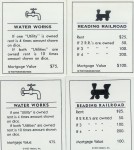 I found an unissued stock certificate for the Atlantic City and Shore Railroad at the site for George H. LaBarre Galleries, Inc., a company in Hollis, New Hampshire. For such a rare stock certificate in excellent condition, the $75 price tag seems reasonable. LaBarre also sells the “Monopoly Game Board Set” with the B&O, Pennsylvania, and Reading Railroad stock certificates.
I found an unissued stock certificate for the Atlantic City and Shore Railroad at the site for George H. LaBarre Galleries, Inc., a company in Hollis, New Hampshire. For such a rare stock certificate in excellent condition, the $75 price tag seems reasonable. LaBarre also sells the “Monopoly Game Board Set” with the B&O, Pennsylvania, and Reading Railroad stock certificates.
With all four certificates, you can add the cards from a real Monopoly game, $200 in Monopoly money for each, plus $200 for the rent that would have to be paid if someone landed on your railroad. You should also find the “Take a Ride on the Reading” and “Advance token to the nearest Railraod and pay owner Twice the Retal…” cards. Put it all together in a frame and hang it in your game room.
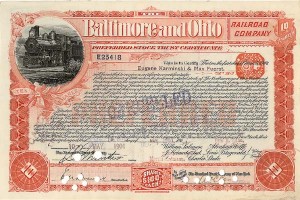
Baltimore & Ohio Railroad.

Pennsylvania Railroad stock certificate with famous horseshoe curve train scene.
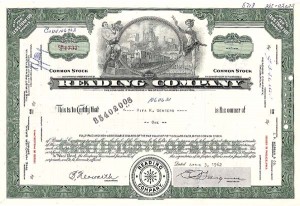
Reading Company, owner of the Reading Railroad.

Atlantic City and Shore Railroad, operator of the Shore Fast Line (Short Line in Monopoly)
And with that, you can have a lot of fun with the part of numismatics known as scripophilly!
I have no connection with
George H. LaBarre Galleries. Since I am using their images, I think it is only fair to give the company credit and, hopefully, steer some business their way. So if you are interested in these or other scripophilly items,
shop their online catalog!
Apr 18, 2014 | cash, dollar, pocket change, US Mint
Earlier this week I drove up north to Long Island to spend holidays with relatives. Taking these rides reminds me that we do not live forever. While the family has been expanded with children, the number of relatives at the seder is lower than it was just 10 years ago and these trips are punctuated with trips to the cemetery.
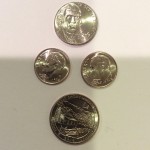
2014 coins found in change during a recent drive to New York
During one of our necessary stops, I was handed some change and noticed that the dimes looked a bit shinier than usual. Quickly zeroing in on the date I saw the “2014” date. After searching all over the Washington, D.C. area for 2014 coins, I find my first somewhere on the road in New Jersey.
Later that evening I emptied my pocket to see what else I could find. In addition to the dime, there was a 2014-P nickel and a surprise.
In 1979, the Susan B. Anthony dollar was released to much fanfare. It was the first “small” dollar coin and was the first U.S. coin to feature a real woman. Prior to the famed suffragette being featured on a coin, the image was that of Lady Liberty in some form. Even the Indian Head cent was not an Indian but Liberty in a native headdress.
But those of us who watch the experiment first hand soon discovered that the coin was too close in size with a quarter. In fact, the color, and reeded edges saw the Susie B. consistently being mistaken for quarters.
Almost as instantly as they appeared, the coins disappeared. Even as the public was willing to try the new coins, the rejection was almost as quick. After three years of production, the coins found a home in Las Vegas where they were used in slot machines. So many coins went unused following their last production in 1981 that was mainly for collectors, production picked up in 1999 after orders for additional coins were made from the vending machine and Las Vegas gaming industry.
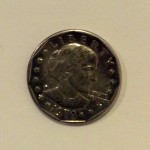
The ’79 Susie B. that I received in change that was probably mistaken for a quarter.
I suspect that someone who previously visited that roadside oasis (how’s that for a description of a rest stop along the New Jersey Turnpike), used one of the vending machines, then spent the dollar thinking it was a quarter. The coin sat in the tray in the cash register until it was time to provide change for my purchase. The cashier, not paying attention to what she was doing, counted the requisite number of coins from the quarter section of the draw. In a rush, I just saw what was the right size coin and dropped it into my pocket on my way back out of the building.
Starting in 2000, the dollar was changed to not only honor Sacagawea but magnesium was added to the metal mix to give the coins a golden color. The color and making the edge smooth made it less possible that the coin would be mistaken for a quarter. Unfortunately, the memory of the failed Susie B. lingers among a significant segment of the population in a way that kept a similar push with the modern Presidential dollars from being successful.
But in this case, finding a Susan B. Anthony dollar made my day!
Apr 11, 2014 | advice, coins, security, technology
 Computer and online security has been a topic for the news lately. This was because of a mistake made in software that was being used to try to keep your password from being seen by criminal hackers was making it visible to those criminals. In the wake of the news, the Doug Davis of the Numismatic Crime Information Center sent out a message to his list of contacts that had one central message for every dealer and collector:
Computer and online security has been a topic for the news lately. This was because of a mistake made in software that was being used to try to keep your password from being seen by criminal hackers was making it visible to those criminals. In the wake of the news, the Doug Davis of the Numismatic Crime Information Center sent out a message to his list of contacts that had one central message for every dealer and collector:
Shooting simple photos from your smart phone or personal camera can lead criminals right to your location… with pinpoint accuracy using GPS satellites.
You might have heard the term “metadata” in the news in the context of its collection by the National Security Agency. For those who do not know what metadata is, think of it as a description of the data. Think about an exhibit in a museum. The exhibit contains several artifacts arranged in a certain way to try to tell a story. But the story is incomplete because a little more information is needed to put it into context. But the information cannot be shown as an artifact in the exhibit, so the person setting up the exhibit adds a description added to the exhibit to make it more understandable. That description would be the metadata to the exhibit.

Example of what you can find out about your image in the file’s Properties under Windows
Modern cameras, cameras built into smartphones, and even some memory cards that can be inserted into older cameras can determine where you are located and record that in the metadata in the picture you take. And contrary to what you have read, new technologies do not have to use the Global Positioning System (GPS) to figure out where you are located. There are services that use WiFi to record your position. It is called WiFi Positioning System (WPS). Basically, WPS determines where it is located and communicates that to WiFi connected services so that it could be used to determine your location.
I know geotagging can be a lot of fun. A few years ago when my wife and I drove from Portland, Maine to Canada, I had taken pictures of the scenery along the way hoping to find a moose. After all, how can you go through the woods of Maine without seeing a moose?! When I loaded the pictures on my Mac in iPhoto, it was fun to see the plot of where the pictures were taken on the built-in map. I was able to follow the road into Canada just based on the geocodes.
What I did not do is post those pictures while on the road. Aside from the lack of cellular connectivity, posting those pictures would advertise to evil doers that I was not home and too far away to do anything.
If you take geocoded pictures of your coins and post them online, whether it you are posting them to a social media site or a discussion forum, you are advertising where the coin is located. This might not be a problem if you collection consists of what dealers would call ordinary or common coins. But if that 1937-D Buffalo nickel has only three legs, that geocoded picture announces that you have at least one high value coin that someone might want to acquire through less than legal means.
The problem is that I love to see pictures of interesting coins. This is one of the reasons I love Pinterest. Aside from sharing my own picture, Pinterest allows me to pin coin images from around the Internet to create virtual scrapbooks. Do you have an interesting coin? I want to see it. Different types of tokens and medals are excellent artwork.
However, when you take the pictures of your prized collection, make sure you turn off geotagging!
Unfortunately, I cannot tell you how to do it on every camera because the process is different. To help, I found the following two articles that provides an overview of how to turn off geotagging on the common smartphones:
- “How to Disable Geotagging on Your iPhone, Android Phone or Blackberry”
- “How to disable a smart phone’s geotagging feature”
For other cameras, you need to find the manual that came in the box to figure out how to do this.
In the meantime, stay safe online and let’s see those beautiful coins!
Apr 10, 2014 | coins, commemorative, commentary, legislative, policy, US Mint
 Amongst all of the noise on Capitol Hill, the one area where no noise has been made is in the numismatic arena. For the last three months there has been no bill introduced, heard in committee, or acted on by either chamber of congress. Although there have been some hearings on a few issues, the last numismatic-related bill that had any congressional action was the introduction of the Pro Football Hall of Fame Commemorative Coin Act, S. 1842, introduced by Sen. Rob Portman (R-OH) in December.
Amongst all of the noise on Capitol Hill, the one area where no noise has been made is in the numismatic arena. For the last three months there has been no bill introduced, heard in committee, or acted on by either chamber of congress. Although there have been some hearings on a few issues, the last numismatic-related bill that had any congressional action was the introduction of the Pro Football Hall of Fame Commemorative Coin Act, S. 1842, introduced by Sen. Rob Portman (R-OH) in December.
This type of inactivity is unusual for congress. Regardless of party, congress is always looking to curry favor with their constituents and groups associated with their constituents by introducing commemorative coin legislation. Over the last few congresses (a two-year term), there will be over 40 coin-related bills that die in committee where very few even get a cursory hearing.
This does not mean there will be no commemorative coins in the near future. Now, the U.S. Mint has issued the Civil Rights Act of 1964 Silver Dollar and National Baseball Hall of Fame commemoratives. In fact, the Baseball Hall of Fame coins are so popular that the gold option has sold out of its 50,000 statutory mintage limit.
As an aside, a friend pointed out that the U.S. Mint did not bring 50,000 gold coins to the Whitman Baltimore Expo and wondered how many of those coins were purchased by baseball’s owners and members of the Baseball Hall of Fame. It would be interesting to see the effect of organized baseball on the sale of these coins.
In 2015, the U.S. Mint is scheduled to release a March of Dimes Commemorative Silver Dollar commemorative coin. Founded in 1938 by President Franklin D. Roosevelt to combat polio, the March of Dimes changed its mission to combating birth defects after the discovery of the polio vaccine by Dr. Jonas Salk in 1954. Salk’s work was supported by the organization.
Also on the schedule for 2015 is the United States Marshals Service 225th Anniversary commemorative coin series. The Marshal Service commemoratives will include a gold $5, silver dollar, and clad half-dollar coins. I do not think this will be as popular as the 2005 Marine Corps 30th Anniversary commemorative coins.
Officially, the 2016 scheduled commemorative will be the Mark Twain Commemorative coin program that will only include gold $5 and silver dollar coins. However, considering Twain’s mindset about being famous, I think he would be amused by having a commemorative coin made in his honor. I might call it the “Mark Twain Amusement commemorative.”
The only other commemorative coin with legislation that has passed congress and signed by the president is the 2017 Lions Clubs International Century of Service Silver Dollar.
Given the law says that there will be no more than two commemorative coin series per year (31 U.S.C. §5112(m)); and given that the next time only one commemorative coin is scheduled to be issues is in 2016, there is plenty of time for congress to do “something” and pass one of the bills that is currently waiting for their action.
Apr 5, 2014 | Baltimore, coins, commemorative, gold, silver, US Mint, video

2014 National Baseball Hall of Fame Commemorative Proof $5 gold coin obverse
It has been speculated that the U.S. Mint will strike more coins than the law (Public Law 108–291 [PDF]) allows on order from the Secretary of the Treasury. No official decision has been announced by either the U.S. Mint or the Department of the Treasury. However, it is questioned whether it is legal for the Secretary to make this decision unilaterally or requires an act of congress. There seems to be evidence that someone had previously approved an increase for the 2005 Marine Corps Commemorative dollar, but there is no authoritative source for proof.
Collectors who have contacted me are not happy with the U.S. Mint. Many believe that the high limit (50 coins per “household”) was too high. When I posted images of the graded baseball coins, several commented that they felt that dealers “abused” their access to the immediate supply of coins that were available in the U.S. Mint booth at the Whitman Baltimore Expo that many collectors did not have a fair chance.
None of my correspondents would bemoan a dealer’s ability to make money on the secondary market. But to do so by taking advantage of the U.S. Mint’s inability to manage its market as the lone producer of U.S. commemorative coins was considered excessive by many. Although I sympathized with their point of view since I could not purchase one for my collection, I questioned whether the U.S. Mint has an obligation to just sell the coins or satisfy market forces. But as many pointed out, the U.S. Mint is a government agency and has a responsibility to the people of the United States and not just the corporations.
While at the Whitman show I spoke with one of the U.S. Mint employees who said that they should have limited the number of coins someone can purchase at one time. Although they did enforce lower limits on the supply of coins sold on Saturday, the damage had been done leaving collectors to scramble to buy the coins on the secondary market or order them online. Those of us who order the coins from the U.S. Mint online catalog will have to wait until June 21, according to the notice sent to me. However, the website is saying that the proof dollar is backordered until July 7 while the clad proof half-dollar is will be available on April 10.
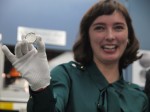
Cassie McFarland holds up Baseball Hall of Fame Commemorative Dollar with her design
We are talking about baseball, America’s pastime. America’s game. Regardless of the accepted story of its founding, it is generally accepted that Major League Baseball was founded in 1869 making it the oldest organized league in North America. Not only was the coin released just before Opening Day for 2014, but the National Baseball Hall of Fame and Major League Baseball have been promoting this coin since the bill was signed.
To even hint that this was going to be a situation like the failure of the 2013 Girl Scout Commemorative would be very short sighted and foolish.
Maybe the U.S. Mint should review its sales processes than chase after pattern coins.
In the mean time, the U.S. Mint published a B-Roll for the National Baseball Hall of Fame Commemorative.
Coin image and B-Roll footage courtesy of the U.S. Mint.
Image of Cassie McFarland courtesy of the
San Francisco Examiner.



 While all this seems simple to me, I have been in this industry for over 30 years and am used to the complication. The problem with email is that it was developed as a way for researched to communicate by plain text across the Arpanet, the forerunner of the Internet. Essentially, email is a text-based service that has been extended in so many ways that it has created a complicated series of standards that requires a degree in computer science to analyze.
While all this seems simple to me, I have been in this industry for over 30 years and am used to the complication. The problem with email is that it was developed as a way for researched to communicate by plain text across the Arpanet, the forerunner of the Internet. Essentially, email is a text-based service that has been extended in so many ways that it has created a complicated series of standards that requires a degree in computer science to analyze.












